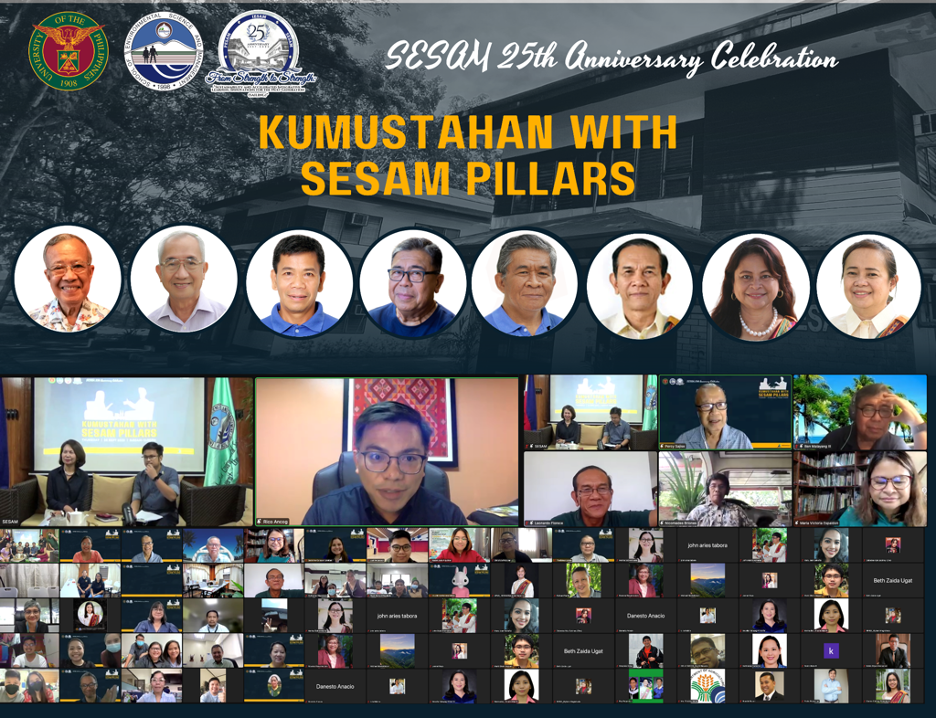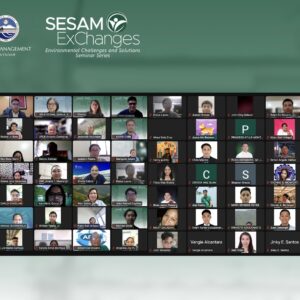UPLB-SESAM conducts Virtual ‘Kumustahan with SESAM Pillars’
The University of the Philippines Los Baños – School of Environmental Science and Management (UPLB-SESAM) in partnership with the UPLB Environmental Science Society conducted its “Kumustahan with the SESAM Pillars”, last September 29, 2022. About 110 participants consisting of SESAM faculty and staff, students, and alumni attended this highly anticipated mini online reunion of SESAM Pillars held via zoom and Facebook Live Streaming. More than just reminiscing of the past, this “Kumustahan with the SESAM Pillars” also aims to connect the past with the present and the future of the School.
Among the SESAM Pillars attended the event are Dr. Percy E. Sajise, Former Director and Professor (PESAM, 1977-1985); Dr. Enrique P. Pacardo, Former Director and Professor Emeritus (IESAM, 1985-1991); Dr. Nicomedes D. Briones, Former Director and Professor (IESAM,1991-1995); Dr. Ben S. Malayang III, Former Director/Dean and Professor (IESAM/SESAM, 1995-2001); Dr. Maria Victoria O. Espaldon, Former Dean and Professor (SESAM, 2006-2012); Dr. Leonardo M. Florece, Former Dean and Professor (SESAM, 2012-2015); and Dr. Decibel V. Faustino-Eslava, Former Dean and Professor (SESAM, 2015-2021).
In his welcome message, SESAM Dean, Dr. Rico C. Ancog, highlighted the celebration of the 25th Anniversary of SESAM as a School. He mentioned that this “Kumustahan with SESAM Pillars’, is the SESAM’s tribute to the pillars of the beloved School. With the theme, “From Strength to Strength: Sustainability and Accelerated Integrative Learning Innovations for the Next Generation”, or SAILING, Dr. Ancog mentioned that this is the fortunate time to look back into the journey of SESAM, to learn a number of lessons from the past and to reflect on the things that need to improve to be able to move forward better.
“We have long sailed but we also need to reflect on how we can sail better,” said Dean. Ancog. “We want to make sure that our students will then appreciate the journey of our school and will be even more inspired by the stories to be shared by our pillars”, he added.
Dr. Ancog shows gratitude and thanks to all the SESAM Pillars in making time to attend the event and share their journey to the young generation of environmental leaders in SESAM.
SESAM pillars traced the School’s roots back to 1977 when it started as a Program on Environmental Science and Management (PESAM). According to Dr. Sajise, PESAM popularized a number of research methodologies in UPLB such as Rapid Rural Systems Appraisal, Assisted Natural Regeneration, and Environmental Impact Assessment. Each of the pillars shared their experiences on how SESAM evolved through time.
Dr. Pacardo highlighted the start of the idea of interdisciplinarity that is currently evolving at that time. According to him, the idea of environmental science emerged due to the challenge in integrating different sciences into a single discipline.
“It is a challenge. We are dealing with an ecosystem which is multifaceted. We lack a framework of a complex system”, said Dr. Pacardo. He also added that the idea of interdisciplinary approach to solve complex problems became the pillar for an intellectual atmosphere.
Dr. Sajise said, “SESAM was born out of recognition of the need to find solutions to the complex environmental problems”. He also discussed that the complexity of these environmental problems came about because of the interactions between human and the environment and it became more complicated so the response was and has to be effective also. And this response generated the vision, the recognized need. And this vision was to create an institution in the academe which will respond to this need over a long term, spanning generations of the students, researchers, resource users, policy makers and the general educational sector.
“Making this vision into reality was not easy”, said Dr. Sajise.
Dr. Briones then recalled how he became part of the institution. He was recruited as a Research Assistant by Dr. Sajise until he became a faculty member and a Director in 1991. According to Dr. Briones, the 1980s is the momentous year for the development of sesam as an academic unit of UPLB and the 1990s is the period when IESAM was catapulted to become a school. He also mentioned that the Environmental Education Network of the Philippines (now Philippines Network of Educators on Environment or PNEE) was the idea of IESAM to gather other environmental science institutions in the country. Dr. Briones also mentioned that the EENP became the vehicle of SESAM to spread environmental science in the country with funding support from the Environment and Resource Management Project, a joint project between IESAM and Dalhousie University.
Dr. Ben S. Malayang III was also recruited by Dr. Sajise. “I knew that SESAM was going to make a difference in the country. Then I joined sesam and I have not regretted it”, said Dr. Malayang. He raised the challenge of being able to flex and be flexible with the mindset and mindscape to solve environmental issues that have been altered very significantly following the great acceleration of the changes created in our world.
“Rather than thinking of isolates, we must create a mindset of being ecosystemic to be able to understand the situation more and especially ask the right questions first. But that mindset is to be within the context of a clear landscape of mind – the mindscape.”, Dr. Malayang explained.
He also said that aside from focusing on the ecosystem which SESAM has been doing over the years, it is high time to focus into the mindscape of meta ecosystems where we begin to grapple issues of the very close interactions of geospheric, biospheric, and ethnospheric dynamics.
Recruited also by Dr. Sajise, Dr. Espaldon reminisced about how she became part of SESAM and how she wanted to become part of SESAM all the way. She said that she entered the institution when SESAM was at the crossroads of challenges.
“The essence of the university is learning so the center of the university are the learners and because we are also part of the national university – UP, we also have a mandate to become a research and graduate university and I think that one’s stick to my mind when I assumed the leadership”, said Dr. Espaldon. According to her, the crowning glory of SESAM is its extension and public service. And when it became a CHED Center of Development in Environmental Science, SESAM continues to confront emerging environmental challenges of the country and the region.
Dr. Florece assumed the Deanship after Dr. Espaldon and he continued the work started by the previous Dean. With the growing number of students applying and enrolling in the SESAM’ s graduate program in his time, Dr. Florece recruited more Faculty and Researchers from different fields of science to SESAM.
“Environmental science is so broad, but during my time, we were guided by our vision and mission. We need to start first by looking at what is happening around us because as time goes by, we face new environmental problems. It is like an ecological time bomb”, said Dr. Florece. “SESAM is so small but our concern is so broad that we need collective efforts from different fields of social and hard science”, he added.
And with the increasing number of students, Dr. Eslava who assumed the position after Dr. Florece worked to double the number of the faculty members. Addition of new people from different fields of expertise not only to lessen the load of mentoring the students but also to diversify the courses, to diversify the researchers and also the extension services of SESAM.
“SESAM has had a very long and proud history like a fully grown tree, I was simply harvesting the fruits of the labors of those who came and worked before me”, said Dr. Eslava. In her time, SESAM elevated and became the CHED Center of Excellence in Environmental Science and with its mandate, SESAM expanded its expertise to support other State Universities and Colleges (SUCs) and to provide improved offerings of environmental science in the nation. She mentioned the establishment of the Philippine Environmental Science Association or PESA through the leadership of Dr. Espaldon to support this mandate.
The year 2020 hit the nation very hard. Starting with the eruption of Taal in January 2020 followed by the pandemic and stronger typhoons hitting the country, Dr. Eslava believed that behind these problems and issues, there are opportunities for us in environmental science.
“We must always be on our toes and be at the forefront of looking into those problems, training the students to understand them and to contribute to addressing those issues”, Dr. Eslava added.
After a fruitful conversation and exchanges with the SESAM Pillars, the winners of the SESAM Nationwide Digital Environmental Making Contest joined by Junior and Senior High School Students (Category 1) and College Students (Category 2) and the winners of the SESAM 25th Anniversary Essay Writing Contest participated by UPLB students were also announced.
SESAM Alumna, Ms. Nyhria G. Rogel and UPLB Environmental Science Society President, Mr. John Raphael O. Artates served as the masters of ceremony in this half-day event. (RDAreglado)







